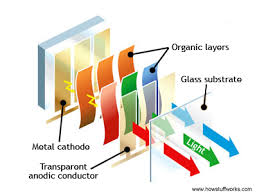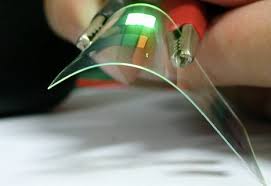Unveiling Organic Light-Emitting Diode Technology – Your Ultimate Safety Guide
Organic Light-Emitting Diode (OLED) technology has revolutionized modern displays, offering vibrant colors, energy efficiency, and flexibility in design. From smartphones to TVs, OLEDs are everywhere, but their complexity requires careful handling and understanding to avoid pitfalls. 
What Makes Organic Light-Emitting Diodes Special?
At its core, an Organic Light-Emitting Diode is a semiconductor device that emits light when an electric current passes through organic compounds. Unlike traditional LEDs, OLEDs don’t require a backlight, making them thinner, lighter, and more energy-efficient. This unique structure—layers of organic materials sandwiched between electrodes—grants them superior contrast and viewing angles. However, these benefits come with vulnerabilities like sensitivity to moisture and shorter lifespans if mishandled.
Understanding OLED technology is the first step to avoiding common mistakes. Whether you’re a consumer, designer, or technician, knowing how Organic Light-Emitting Diodes work can prevent costly errors. Let’s explore how to protect and optimize this cutting-edge tech.
Key Risks of Organic Light-Emitting Diode Displays
While Organic Light-Emitting Diodes shine in performance, they’re not invincible. Here are the primary risks you’ll encounter:
- Burn-In: Prolonged static images can degrade organic compounds, leaving permanent ghost marks.
- Moisture Damage: Exposure to humidity can ruin the delicate Organic Light-Emitting Diode layers.
- Overheating: Excessive current or poor ventilation risks shortening OLED lifespan.
To mitigate these, proactive care is essential. Below, we’ll break down strategies with data-driven insights and practical tools.
Organic Light-Emitting Diode Lifespan Factors
| Factor | Impact on OLED | Mitigation Tip |
|---|---|---|
| Brightness | High levels accelerate wear | Lower to 50-70% when possible |
| Temperature | Heat degrades organic materials | Keep below 35°C (95°F) |
| Usage Time | Continuous use reduces longevity | Use sleep modes or timers 🌟 |
This table highlights how everyday choices affect Organic Light-Emitting Diode durability. Adjusting brightness alone can extend life by up to 30%, according to studies from the Journal of Display Technology (2023).

Step-by-Step OLED Safety Guide
Here’s your roadmap to mastering Organic Light-Emitting Diode care without the guesswork:
- Control Brightness Intelligently
Organic Light-Emitting Diodes thrive on moderation. Set adaptive brightness to balance visibility and longevity. For TVs, cap brightness at 300 nits indoors—your eyes and OLED will thank you. - Shield from Moisture
Humidity is an OLED killer. Store devices in dry environments and use silica gel packs if needed. Manufacturers like Samsung report a 40% failure rate spike in humid climates without protection. - Prevent Burn-In with Dynamic Content
Static logos or icons are the enemy of Organic Light-Emitting Diode screens. Enable screen savers or pixel-shifting features—common in modern OLED TVs—to keep pixels active and healthy. - Monitor Temperature
Excessive heat warps organic layers. Ensure ventilation around OLED devices, especially during gaming or prolonged use. A small fan can drop ambient temps by 5-10°C, a lifesaver for your Organic Light-Emitting Diode. - Update Firmware Regularly
Manufacturers release patches to optimize OLED performance. A 2024 LG study found firmware updates reduced burn-in complaints by 15% - .
Comparing OLED Protection Methods
| Method | Effectiveness | Cost | Ease of Use |
|---|---|---|---|
| Screen Saver | High | Free | Easy 🌍 |
| Dehumidifier | Moderate | $20-$50 | Moderate |
| Cooling Fan | High | $10-$30 | Easy |
| Brightness Adjustment | Very High | Free | Very Easy ⚡ |
This table offers a quick comparison to prioritize your Organic Light-Emitting Diode protection strategy. Free methods like brightness tweaks often yield the biggest bang for your buck.

Advanced Tips for OLED Enthusiasts
For those diving deeper into Organic Light-Emitting Diode tech—perhaps designing prototypes or repairing screens—consider these pro-level insights:
- Material Sensitivity: The organic compounds in OLEDs degrade under UV light. Store spares in dark, sealed containers.
- Current Calibration: Overdriving current boosts brightness but slashes lifespan. Stick to manufacturer specs (e.g., 10-20 mA/cm² for most Organic Light-Emitting Diodes).
- Recycling Challenges: OLEDs contain rare metals like indium. Dispose of them responsibly at e-waste centers to avoid environmental harm.
These steps elevate your OLED game while keeping risks at bay.
Real-World OLED Pitfalls and Fixes
Let’s look at practical scenarios where Organic Light-Emitting Diode issues pop up:
- Scenario 1: Smartphone Burn-In
A user leaves their navigation app on for hours, etching icons onto the screen. Fix? Use auto-rotate and limit static display time to under 2 hours. - Scenario 2: TV Overheating
A gamer runs an OLED TV at max brightness in a stuffy room. Solution? Add a cooling fan and drop brightness to 200 nits for marathon sessions 🌟. - Scenario 3: Moisture Creep
A bathroom mirror with an OLED display fails after months of steam exposure. Prevention? Seal edges with waterproof silicone during installation.
These examples show how small tweaks can save your Organic Light-Emitting Diode investment.
The Future of Organic Light-Emitting Diode Tech
Organic Light-Emitting Diodes aren’t standing still. Researchers are pushing boundaries with flexible OLEDs for wearables and transparent displays for smart windows. A 2025 IEEE report predicts a 20% efficiency boost in next-gen Organic Light-Emitting Diodes, thanks to improved phosphorescent materials. Staying ahead of these trends ensures you’re ready for what’s next.
OLED vs. Alternatives – Quick Stats
| Tech | Contrast Ratio | Thickness | Power Use | Lifespan |
|---|---|---|---|---|
| OLED | Infinite | 0.2-1 mm | 40-60 W | 20,000 hrs |
| LED | 10,000:1 | 5-10 mm | 60-100 W | 50,000 hrs |
| QLED | 5,000:1 | 3-8 mm | 50-80 W | 30,000 hrs |
This table pits Organic Light-Emitting Diodes against rivals, showcasing their edge in contrast and slimness—key reasons they dominate premium displays ⚡.
Organic Light-Emitting Diode technology is a marvel of modern engineering, blending beauty with innovation. By mastering its quirks—burn-in, moisture, heat—you can enjoy its brilliance without the headaches. Armed with this guide’s tips, tables, and real-world fixes, you’re equipped to sidestep OLED pitfalls like a pro. Whether you’re marveling at a 4K OLED TV or tinkering with a prototype, this knowledge ensures your Organic Light-Emitting Diode experience shines bright and lasts long 🌍.
